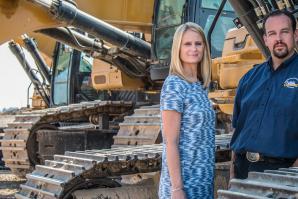It was David Mering’s turn to share. On a conference call in March 2020 with a group of independent advertising agencies, he looked a bunch of other CEOs in their virtual eyes and confessed that COVID-19 put Mering, the Sacramento-based branding company he founded in 1985, in a chokehold. It was tough to admit. Other owners had shared minor updates, nothing catastrophic. But most of Mering’s clients came from the travel industry, so the agency (whose motto is “We move people”) found itself at the mercy of a pandemic.
“You can imagine, when everything went into lockdown, we were hit pretty hard,” Mering says. “Everyone went around and told stories, but my story was much more dire: revenue loss, layoffs, salary cuts, furloughs. It was very traumatic for the organization.”
But the story didn’t end there. After the meeting, Mering got a call from Rick Milenthal, CEO of Ohio-based marketing agency, The Shipyard, and chairman of its parent company, TSY Enterprises. TSY wanted a deeper presence in California, and over the next six months, the two companies put together the foundation of a deal to merge, which was finalized in December 2020.
“He said he was moved by our situation,” Mering says. “He said, ‘I think we can help you and do something together that’s going to be fantastic.’ Given the condition we were staring at, I was not expecting that. I said, ‘OK, let’s see where this goes.’”
Many businesses in many sectors felt the sting of the shutdown. But the recent spate of mergers and acquisitions in the Capital Region tells a story beyond the pandemic, speaking to growing interest in the area and a red-hot financial craze that catapults private companies into public markets.
The biggest deal came from Origin Materials, a West Sacramento-based green-tech company that uses patented techniques to convert wood chips into renewable plastics to replace petroleum-based materials. Founded in 2008, Origin announced in February a nearly $1 billion merger with Artius Acquisition, a New York-based special purpose acquisition company, or SPAC. The combination is set to create the first publicly traded carbon negative materials company. With an estimated value of $925 million, the transaction is technically a merger, but strategically, the goal was for Origin to go public.
“We were never looking to get acquired — that was never the endgame,” says John Bissell, Origin’s cofounder and co-CEO, who will continue leading Origin. “We didn’t know if we would end up in public markets or stay private. The SPAC process is a merger-orientated process, but the result is basically an IPO.”
Motives for Merging
For some companies, the process to merge or be acquired was already in the works prior to 2020 as Sacramento fixtures (such as Lyon Real Estate and Allworth Financial) looked to move in a different direction. But for businesses writhing from last year’s downturn, a merger or acquisition may serve as an exit strategy instead of shutting down or selling assets piecemeal, says Vusal Eminli, an associate professor of finance at the University of the Pacific’s Eberhardt School of Business.
Scott Hanson (left) and Pat McClain agreed to sell controlling
interest in Allworth Financial last year, but they will continue
to manage the company they founded in 1993. (Photo courtesy of
Allworth Financial)

“One of the major economic impacts of the COVID-19 pandemic has been the structural shifts it has caused in the business environments of many of the industries,” he says. “Firms that are not able to cope with this changing environment have to exit the market, which creates room for further consolidation through mergers and acquisitions.”
There are three different factors why a merger or an acquisition may happen: expansion of market power, synergistic gains or managerial reasons. In some cases, the result can be good for all parties. But some mergers and acquisitions may not be beneficial — at least not to consumers.
“(The Shipyard CEO Rick Milenthal) said he was moved by our situation. He said, ‘I think we can help you and do something together that’s going to be fantastic.’ Given the condition we were staring at, I was not expecting that. I said, ‘OK, let’s see where this goes.’”
DAVID MERING Founder, Mering
“Of course, this is not what we want to see in the economy,” Eminli says. “Companies eating up other companies for market space hurts customers. It eliminates competition and typically results in higher prices for customers for lower quality products and services.”
The Federal Trade Commission and the U.S. Department of Justice review mergers and acquisitions to make sure they won’t greatly lessen competition and negatively affect customers. But to get flagged for federal review, the acquirer must come in possession of at least $94 million worth of the assets or securities of the other party as a result of the deal. Smaller deals can fly under the radar.
Alternative Models
In Origin’s case, the company needed capital to scale and grow fast, but serious investments in climate tech just weren’t happening 10 years ago. That didn’t stop Bissell and co-CEO Rich Riley from staying the course. They spent the past decade developing a “drop-in ready” replacement for petroleum, such as recyclable, plant-based plastics.
“We were skating to where the puck was going to be,” Bissell says. “All the way along, we were the only ones out there who thought the puck was going to be there someday.”
To weigh its options, Origin hired a banker to explore private financing and SPAC financing at the same time. A SPAC is a blank-check company with no specific business plan except to finance mergers and acquisitions as an alternative route to an IPO. These types of deals used to be back-of-the-shelf financial models on Wall Street, but in 2020 they emerged as popular investment vehicles, spearheading a record year for IPOs.
The $78 billion raised last year by SPACs in the U.S. was more than the combined total of SPACs in all years prior and accounted for about half of 2020’s record $177 billion IPO volume, according to Bloomberg. The SPAC boom isn’t a one-off either. The frenzy has continued into 2021. Goldman Sachs strategists predict that SPACs, which emerged in the 1990s, could drive $300 billion in mergers and acquisitions activity over the next two years.
In a pandemic-ridden world, Bissell says, investors have a different relationship with risk. The warnings about a pandemic went unheeded for so long, and then the coronavirus hit, which has caused the world to think seriously about putting money toward companies on a mission to prevent or reverse projected disasters, including environmental ones.
“The ramp up in urgency around climate change has been dramatic,” Bissell says. “It’s hitting just as we’re ready to really scale.”
Help Wanted
For some companies, money is only one piece of a growth pie. For example, Cordico is a Gold River-based provider of mental health wellness solutions for first responders. The company was started by psychologist David Black, who wanted to support firefighters and public safety professionals in a post-9/11 world.
In 2018, Cordico launched an app that put wellness tools and health care resources in the hands of those on the front lines of public safety. Sales have continued to skyrocket as the COVID-19 virus seized the globe, Black says. That “astronomical growth” put demands on Cordico’s talent, content and technology that he says might not have been sustainable without outside support.
In December 2020, Cordico was acquired by Lexipol, a Texas-based provider of policy and training solutions for public safety departments. The acquisition, Black says, provides Cordico with access to marketing and sales teams, leading experts in the professions, cutting-edge technology, and strong financial support.
“As you’re scaling at a faster and faster pace, the need for additional resources across your organization becomes greater and greater over time,” says Black, who is remaining as CEO. “We are very mission-driven to help as many people serving in high-stress professions as possible … including health care workers, first responders and others who put themselves at risk to help their communities every day.”
Like Cordico, Aztec Solar, based in Rancho Cordova, saw a boost in sales despite the pandemic. Deemed an essential business, the company continued selling solar electric systems and had a 25 percent increase in revenue in 2020, says Ed Murray, Aztec Solar’s CEO and president.
“We’re still seeing an increase in sales this year,” he says. “People are still at home, using more electricity. They want to increase the value of their homes and decrease costs and have more battery storage.”
Murray started Aztec Solar in 1980 and sold it the first time in 2007 to a German company. That ended up going bust, and Murray, who could have retired, bought his company back in 2008. But he still wanted to grow his business and install more solar energy throughout the Western U.S. He realized this goal after meeting with Virginia-based Sigora Solar, which acquired Aztec Solar in October 2020.
One of Murray’s demands for the deal was to make sure his 40 employees wouldn’t be left out to dry. The deal with Sigora includes a three-year contract for him to serve as president of the West Coast division and help with the transition.
“I’ve seen what can happen when companies go down and warranties aren’t taken care of,” Murray says. “I want to strengthen consumer protection, get certification for installers, write building codes in state. I know what it takes to make an industry stay in good stead over time, and I want to make sure that when I leave, solar (energy) goes on, not only in the state, but the country and world.”
Stronger Together
Most companies say synergy is the reason for a merger: The combined unit as a whole is superior to the sum of the parts, Eminli says. One source of synergy is that joining together would allow the companies to lower their costs because they can eliminate duplicate costs, such as facilities, equipment, research and development, and advertising.
This type of collaboration allows two companies to work more efficiently as one unit than they would separately, Eminli says. Company A might have valuable know-how and patents that company B could use in conjunction with its own know-how to develop and bring a new or higher quality product to the market.
Eminli believes this could be the motivation behind Lockheed Martin acquiring Aerojet Rocketdyne for $4.4 billion in December 2020. Aerojet Rocketdyne sources declined to comment on the deal until the acquisition becomes official, expected this month.
In October 2020, Allworth Financial sold controlling interest to Lightyear Capital and the Ontario Teachers’ Pension Plan, and the deal closed last December. Allworth Financial co-CEOs Scott Hanson and Pat McClain, who founded the company in 1993, will continue to manage Allworth.
About four years ago, they were looking to add capital and sold a majority stake to Parthenon Capital. Since then, they have done 12 acquisitions, so this is old territory for the duo. They hired an investment banker to go through the process. The concept of a private-equity partner gets a bad rap, Hanson says, but their current partners are growth investors, providing oversight and capital. He adds that this new deal puts Allworth in a position to bring on 1,000 new clients this year in various markets and have between 12 and 15 acquisitions, mainly on the West Coast, by year’s end.
The company rebranded two years ago, changing from Hanson McClain Advisors to the more neutral name of Allworth Financial. The Hanson McClain brand was known in Sacramento, but if it wanted to build a national firm, Hanson says, it needed a name that could resonate with more clients all over. “This clearly wasn’t us selling out to anybody, that’s for sure,” he says.
A Generational Shift
But in some cases, a merger is the best option. Sometimes a company’s managerial structure is lacking, and outside support is necessary. Or a company can be marred with poor management and become a target for acquisition. For Lyon Real Estate, a fixture in Sacramento for 75 years, the future was at stake. The company was acquired in January by Seattle-based Windermere Real Estate.
This has been something the family has entertained for the past few years, according to Pat Shea, president and chief operating officer of Lyon Real Estate (formerly run by real estate mogul Michael Lyon before legal troubles landed him in jail). The pandemic caused a two-month interruption for all companies in the real estate business across the country, but real estate bounced back with a vengeance, he says, especially in Sacramento because of low interest rates, increased migration from the Bay Area, and solid employment numbers among typical homebuyers and sellers.
This deal was more a strategic decision, as the family didn’t have the next generation lined up to take over, Shea says. They are involved in their careers or live in other parts of the world. “I can’t speak for the shareholders,” Shea says, “but this is my understanding of what their mindset is.”
“One of the major economic impacts of the COVID-19 pandemic has been the structural shifts it has caused in the business environments of many of the industries. Firms that are not able to cope with this changing environment have to exit the market, which creates room for further consolidation through mergers and acquisitions.”
VUSAL EMINLI Associate professor of finance, University of the Pacific’s Eberhardt School of Business
To that end, little has changed, and Shea says if there was no announcement of a change of ownership, nobody would know the difference. Lyon let its agents know a month before the deal was official that conversations were well underway so they didn’t find out from other sources. The acquisition introduced more tools, resources and support. The plan is for Shea to continue running the company and leverage the value of the brand, employees and agents.
Lyon did have discussions with other companies, Shea says, but Windermere is family owned with a large philanthropy component, and these factors were key in choosing it. “This is common in business, especially in real estate,” Shea says. “The industry has evolved where you have to get bigger or be part of something bigger. Without having that next generation, it was smarter for Lyon to merge into a like-minded company.”
New Horizons
In Mering’s case, TSY had ambitions to expand, and Mering’s troubled year made the timing right. The companies are taking a methodical approach to integration, trying to avoid any disruptions, and the agency is still called Mering, but that may change in the future. As for Mering, he will be the vice chairman in the new organization and a shareholder. The transition has been a big change for him — he has had his own company since he was 28. He’s now 64.
“Last time I worked for somebody was in the early ’80s,” he says. “You were the guy who makes every decision. Now you talk to people, work it up the system. It will be different.”
But the move gives him time to plan for his next phase. He has been thinking about retirement for 10 years but had no plan prior to this deal. He also agreed to stay with the company for a few years. Some employees have been with him for 20 years, and he couldn’t abandon them.
“I didn’t want to put them in a difficult situation,” Mering says. “Now, they’re part of something bigger. Hopefully, it’ll be something better.”
–
Stay up to date on business in the Capital Region: Subscribe to the Comstock’s newsletter today.
Recommended For You

Providing Funding to Businesses Will Be Crucial in Recovery
In our series, The Big Fix, industry experts explore how the region can rebound from the coronavirus shutdown
When there is change in consumer behavior, there are also opportunities for entrepreneurs with vision, access to capital and the skill to implement successfully.

Rx for Merger Madness
Hospitals and physician practices are consolidating; for businesses covering their workers, that means re-evaluating current plans to keep health care costs from soaring
In the 2019 American economy, the big are getting bigger. Mergers are everywhere — the number of mergers and acquisitions exceeded 15,000 in 2017, a record for a single year, with 2018 a close second.

The Legacy
As Holt of California approaches a crossroads, the company relies on its history of strong leadership transitions
Back in 1998, two family businesses —Holt Bros. and Tenco Tractors — merged into one, for a total of three families now under one business roof at Holt of California. Twenty years later, they rely on a long history of leadership transitions to select the next in line for succession.

Let’s Make a Deal
Business acquisitions are on the rise
If two words could sum up the collective attitudes of those who buy and sell businesses, they’d be “enough already.”




